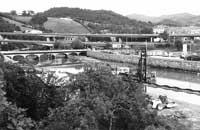Marshes Donostia: RIP
If we had the opportunity to use the time machine and return to San Sebastian about 200 years ago, the landscape we would find in it would have nothing to do with the current one, since in the area occupied by the streets of the current city we would find wide sand and precious marshes. The Urumea, from Martutene, which loses its river character and becomes estuary, vanishes and, forming wide meanders, heads towards the sea, creating in the current neighborhood of Amara large marshes and beaches of silts.
In the end the river faced Igeldo, Urgull and the wide dunes that united the bases of Ulía, exceeding to the maximum that barrier to the sea. Something similar but to a lesser extent could be found in the valley of Ibaeta.
The demographic growth of the Gipuzkoan capital and its consequent expansion. This expansion took place on sand and marshes, destroying that vital wealth forever.
However, until a few months ago between the Iron Bridge and that of Egia, in one of the last sections in which the Urumea estuary was not channeled, one could see a small marsh. They were only a few square meters, surely it would not cover a couple of football fields, but it seems that the aspect that covered this small marsh is "indispensable" for the development of the city. Otherwise, it cannot be understood how the groups that requested the protection of these sections before the pipeline project have not managed to get the political leaders of the City of Donostia to cede. With this last wild channeling, the Marismeño ecosystem has completely disappeared from the mouth of the Urumea; recently it has been included in the list of the rías of the Basque Country (Bilbao, Pasaia…) that have seen destroyed all its natural value in the last century.

Although we accepted that channeling was necessary… were there no alternatives to protect that important aspect ecologically? Could there not be a more "soft" channeling? What would be lost if the channeling had been delayed a few meters, maintaining the marsh? How can one understand that such work is done today, at a time when the words environment and ecology are constantly heard on the lips of politicians? All these questions, in short, highlight the dual language of politicians, since at the same time that the dune and the estuary of Zarautz are declaring Biotopo, extolling the natural value of Urdaibai or Txingudi, these small marshes like that of San Sebastian, have not suffered any confrontation.
Just a year has passed since I published in this magazine a series of articles on the Basque coast. Since then three marshes have disappeared, that of San Sebastian, that of Socoa and that of Saint Bernard in Baiona, and others will disappear shortly if the projects that threaten these environments continue (Plentzia, Ondarroa, Zumaia, Orio, Ziburu, etc. ). This can leave in a very dangerous situation the ecosystem of marshes, one of the most important parts of our natural heritage, as well as in Urdaibai and Txingudi, which have received some institutional recognition, since the degradation has not paralyzed and, in particular, in the case of Txingudi, recovery is increasingly difficult.
In addition, if we do not turn around this situation, the condition will not only be an important reduction in the biodiversity of the Basque Country, but will also have a significant incidence outside our borders. In fact, on 8 April “Conservation of wetlands from the North-South point of view: In the presentation of the book “El camino migratorio Atlántico Este”, the representative of Friends of the Earth, Humberto Da Cruz, clearly explained that the coast of Euskal Herria, despite being a strategic point of this migratory axis, is currently the weakest link. Therefore, his disappearance could have a great influence on the entire migratory axis.
While facts like this are destroying the most important aspects of our natural heritage, our politicians remain disguised as “green”, declaring mountain peaks as Natural Park. There is no doubt that this regrettable current environmental policy must be totally modified. To do this, it would be enough to provide a certain legal personality to eleven environmental studies, catalogues, programs and pre-projects carried out by the institutions, since the problem is not that our environment is not investigated or we still do not know what our most valuable aspects are, but that whenever the time comes to implement effective protection measures, the hidden political and economic interests manage to curb all these projects.
Therefore, if you want to keep these last valuable parts that remain in the environment, you have to design a courageous protection policy; unfortunately, taking into account what we have stated so far, our politicians are far from this type of approach. Meanwhile, excavators continue to destroy the last remnants of our natural heritage.





